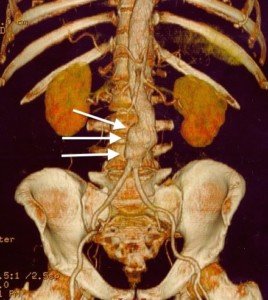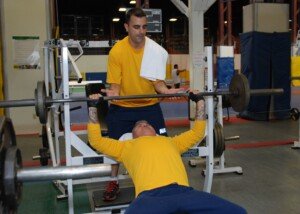
Should people who are symptom-free still be screened for an abdominal aortic aneurysm if they have risk factors such as being a man over age 70 or a smoker with high blood pressure?
Whom should get screened for an abdominal aortic aneurysm even in the absence of symptoms?
This information comes from Peter Gloviczki, MD, a Mayo Clinic vascular surgeon.
That you’ve found this article highly suggests you know what an abdominal aortic aneurysm is and that if it ruptures, death could result in minutes.
Men aged 65 to 75 who smoke, or are former smokers, should be screened for an abdominal aortic aneurysm even if they have no symptoms.
The screening is done with an ultrasound.
However, a sharp medical practice will screen all men in this age group, which is why my father gets this region checked as part of his annual echocardiogram—the technician simply brings the ultrasound transducer down to his abdominal area to get the image/readings of the aorta after she gets the image/readings of his heart.
Having a family history of abdominal aortic aneurysm is another risk factor, even if the patient has no symptoms, and this includes women.
The Society for Vascular Surgery recommends that men who smoke, with no symptoms of abdominal aortic aneurysm, should begin getting screenings at 65. Screenings should start at 55 if there’s a family history.
Dr. Gloviczki says that people with COPD, heart disease, hardening of the arteries or high cholesterol should discuss screening with their doctor.
An AAA is diagnosed mainly with imaging: ultrasound, CT scan and/or MRI.

Source: Bakerstmd
What are the symptoms of an abdominal aortic aneurysm?
Typically there aren’t any. “The problem is patients don’t know they have an abdominal aortic aneurysm and they don’t act expeditiously,” Dr. Gloviczki says. “If you know you have one, you will get to an emergency room.”
He urges people to “react immediately to any new-onset abdominal or back pain,” or even a fainting spell.
Get to an ER ASAP. If you’re in the ER with severe abdominal pain, you should have your abdominal aorta images with an ultrasound—which is much faster than a CT scan or MRI.
When my mother was brought into the ER complaining of agonizing abdominal pain, the ultrasound machine was whisked over to her bed and a doctor wasted no time running the transducer along her abdomen (her aorta was normal).
Treatment for an Abdominal Aortic Aneurysm
The treatment depends on the risk of a rupture, says Dr. Gloviczki. At least one of three requirements = a need for surgical repair: 1) size of at least 5.5 cm, 2) rapid growth, and/or 3) symptoms.
Symptoms of an abdominal aortic aneurysm can include, though rarely, leg pain and blood clots in the arteries of the legs.
If none of these situations are present, the watchful waiting approach is utilized.
Endovascular Surgical Repair of an Abdominal Aortic Aneurysm
More than 70 percent of procedures are done via endovascular, in which a stent is fed through the groin and deploys a graft to reinforce the damaged site.


























